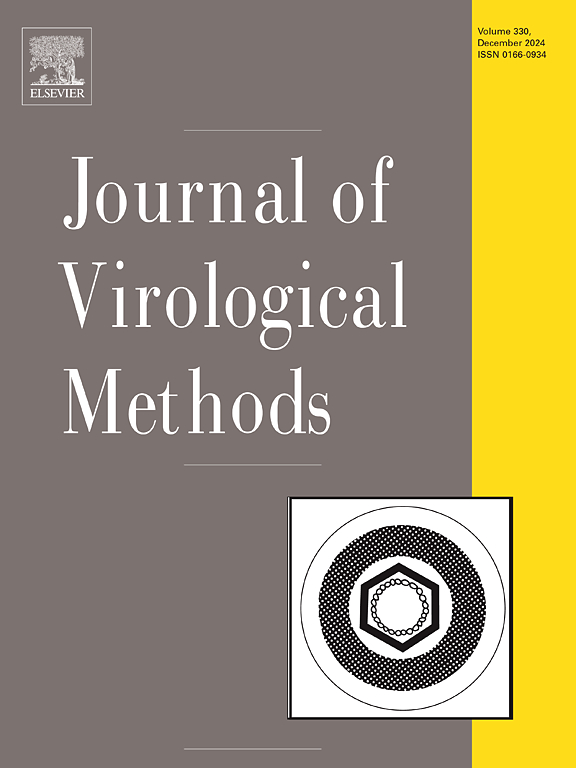三种常见对虾病毒的三重rpa - lfs检测方法的建立
IF 1.6
4区 医学
Q3 BIOCHEMICAL RESEARCH METHODS
引用次数: 0
摘要
本研究主要研究了影响养殖对虾的三种病毒,即白斑综合征病毒(WSSV)、感染性皮下和造血坏死病毒(IHHNV)和陶拉综合征病毒(TSV)。根据各自的保守基因片段设计特异性引物和探针,建立同时检测WSSV、IHHNV和TSV的三重rpa - lfs检测方法。采集7种病原菌和健康对虾组织进行特异性试验。该方法可以特异性扩增WSSV、IHHNV和TSV的基因片段,而没有从健康虾的肌肉组织或其他病原体中扩增片段,特异性强。对反应体系进行了优化,并对其特异性和敏感性进行了验证。采用连续稀释质粒法进行敏感性试验,确定该方法的检测灵敏度为101拷贝/反应。与世界动物卫生组织(World Organization for Animal Health, WOAH,原OIE)推荐的qPCR检测方法的灵敏度相比,本研究建立的三重rpa - lfs方法速度更快,操作更简单。当与实验室标准检测方法同时检测110个样品时,qPCR检测结果与实验室标准方法的结果匹配,一致性率为100 %。这些实验结果表明,本研究建立的三重rpa - lfs检测方法具有特异性高、灵敏度高、检测时间短、准确性高等特点。它可用于WSSV、IHHNV和TSV三种病原体的快速现场检测和诊断。本文章由计算机程序翻译,如有差异,请以英文原文为准。
Establishment of triple-RPA-LFS detection method for three common shrimp viruses
This study focuses on three viruses affecting farmed shrimp, including White Spot Syndrome Virus (WSSV), Infectious Hypodermal and Hematopoietic Necrosis Virus (IHHNV), and Taura Syndrome Virus (TSV). Specific primers and probes were designed by their respective conserved gene fragments to establish a triple-RPA-LFS detection method that simultaneously detects WSSV, IHHNV, and TSV. Seven pathogens and healthy shrimp tissues were collected to conduct specificity tests. This method can specifically amplify the gene fragments of WSSV, IHHNV, and TSV, while no fragments were amplified from the muscle tissues of healthy shrimp or other pathogens, indicating strong specificity. The reaction system was optimized, and specificity and sensitivity were validated. Sensitivity tests were conducted using a continuous dilution plasmid method, determining that the detection sensitivity of this method is 101 copies/reaction. Compared with the sensitivity of the qPCR detection method recommended by the World Organization for Animal Health (WOAH, formerly OIE), the triple-RPA-LFS method established in this study is faster and simpler to operate. When applied to test 110 samples simultaneously with the laboratory standard testing method, the results of the qPCR detection matched the results of the laboratory standard method with a 100 % concordance rate. These experimental results indicate that the triple-RPA-LFS detection method established in this study has the characteristics of high specificity, high sensitivity, short detection time, and high accuracy. It can be used for rapid on-site detection and diagnosis of the three pathogens: WSSV, IHHNV, and TSV.
求助全文
通过发布文献求助,成功后即可免费获取论文全文。
去求助
来源期刊
CiteScore
5.80
自引率
0.00%
发文量
209
审稿时长
41 days
期刊介绍:
The Journal of Virological Methods focuses on original, high quality research papers that describe novel and comprehensively tested methods which enhance human, animal, plant, bacterial or environmental virology and prions research and discovery.
The methods may include, but not limited to, the study of:
Viral components and morphology-
Virus isolation, propagation and development of viral vectors-
Viral pathogenesis, oncogenesis, vaccines and antivirals-
Virus replication, host-pathogen interactions and responses-
Virus transmission, prevention, control and treatment-
Viral metagenomics and virome-
Virus ecology, adaption and evolution-
Applied virology such as nanotechnology-
Viral diagnosis with novelty and comprehensive evaluation.
We seek articles, systematic reviews, meta-analyses and laboratory protocols that include comprehensive technical details with statistical confirmations that provide validations against current best practice, international standards or quality assurance programs and which advance knowledge in virology leading to improved medical, veterinary or agricultural practices and management.

 求助内容:
求助内容: 应助结果提醒方式:
应助结果提醒方式:


